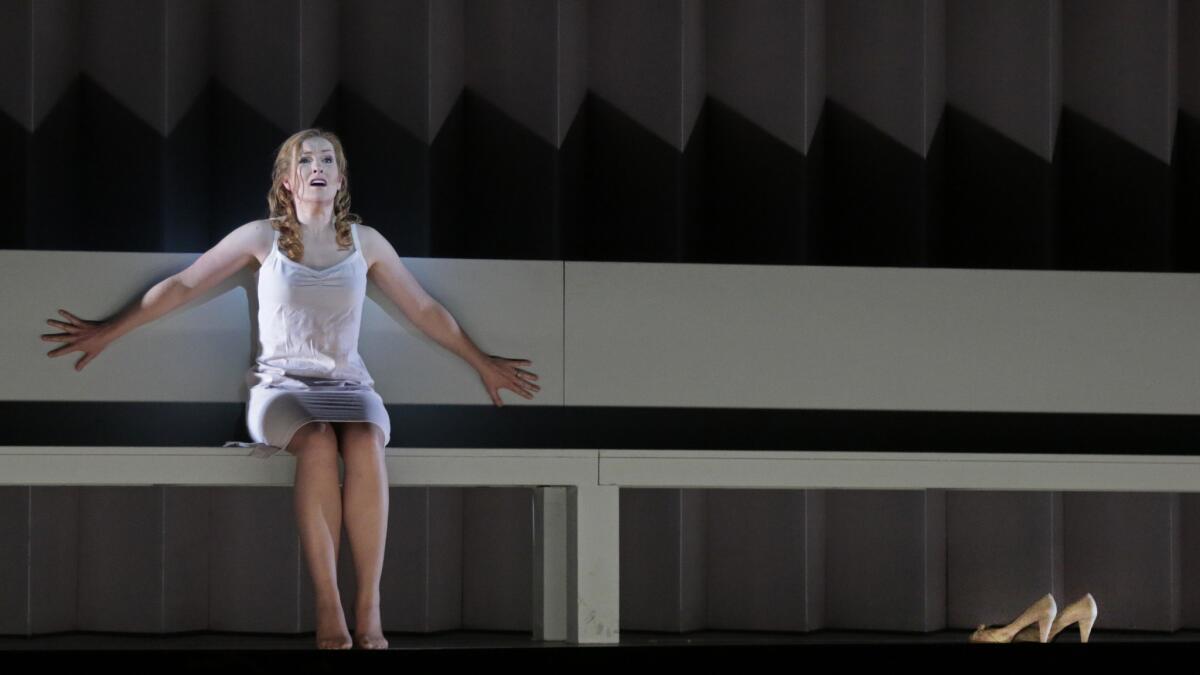L.A. Opera goes minimal with ‘Dido and Aeneas,’ ‘Bluebeard’s Castle’

- Share via
When Los Angeles Opera mounted a cinematically inspired production of Mozart’s “The Magic Flute” last season, audiences marveled at director Barrie Kosky’s innovative combination of animation and live performance.
Those expecting similar delights in the director’s double-bill presentation of “Dido and Aeneas” and “Bluebeard’s Castle,” opening Saturday at the Dorothy Chandler Pavilion, may want to prepare for chilly postmodern minimalism.
With nearly barren sets, stark lighting and little in the way of conventional stage acting, the production serves up a double-scoop of regietheater (German for “director’s theater”), bringing together operas written centuries apart.
“I never try to repeat myself,” said Kosky. “‘The Magic Flute’ was a one-off type thing — this is very different. I don’t think people should be frightened of it.”
Purcell’s “Dido and Aeneas” opens the evening on a set that consists in its entirety of a long white bench — Ikea by way of 17th century England.
The bench is near the edge of the stage, and the opera’s action is confined to lateral movements across the piece of furniture.
“There’s a sense of claustrophobia seeing this one bench crowded with people,” said mezzo-soprano Paula Murrihy, who plays Dido. “It’s an intense performance experience. You don’t have a lot of space to play, but every single gesture means something — when you are that confined, then you see everything.”
“Dido” also features three countertenors who play female roles and who provide something close to comic relief.
The second half of the evening is devoted to “Bluebeard’s Castle,” an essentially two-character opera whose only set is a large Lazy Susan that slowly revolves as the performers enact Bartók’s short opera on its empty surface.
“Physically, it’s demanding,” said bass-baritone Robert Hayward, who plays the monstrous Bluebeard in a modern-day suit. The performers on the turntable must calibrate their movements precisely to its revolutions.
The couple is followed by a series of doppelgangers who don’t sing or speak. “I feel that they are shadows of me. They are like mirrors of what’s going on in my soul,” said Hayward.
This pairing of Purcell’s 1689 opera with Bartók’s 1918 opera was first seen in Frankfurt, Germany, where the double bill premiered in 2010. It has also been seen at the Edinburgh Festival.
For the Purcell, the L.A. Opera orchestra will consist of about 20 musicians playing Baroque-era instruments. The orchestra pit will be raised to audience level so that the musicians are visible in the Baroque tradition.
During the intermission, the pit floor will be lowered to its traditional depth to accommodate an orchestra of around 80 musicians.
“It’s highly choreographed,” said Rupert Hemmings, the company’s senior director of productions.
Both operas will be conducted by Steven Sloane, an L.A. native who lives in Germany.
The conductor, who attended Palisades High School, recalled that his first significant encounter with opera was as a student on a field trip to the Dorothy Chandler to see a New York City Opera production of “Turandot.” He recalled a mishap during the performance that caused part of the stage to collapse.
“Many years later, when I was working at City Opera, I conducted the same production,” he recalled.
Following Saturday’s opening night performance of “Dido/Bluebeard,” Kosky is scheduled fly back to Germany, where he is already at work on upcoming projects. (The Australian-born director heads the Komische Oper in Berlin.)
His diverse plate includes future stagings of “Moses und Aron,” “Fiddler on the Roof” and a production of Wagner’s “Die Meistersinger von Nürnberg” for the Bayreuth Festival.
His highly stylized, sometimes-extreme aesthetic should perhaps not be surprising from a director who counts Fassbinder and Pasolini among his favorite filmmakers.
“I’m influenced by cinema much more than anything in theater today,” he said.
Kosky added that he doesn’t want to intimidate audiences: “I don’t want people to do homework before coming, and the last thing I want to do is alienate. You just have to succumb to the experience.”
Twitter: @DavidNgLAT
More to Read
The biggest entertainment stories
Get our big stories about Hollywood, film, television, music, arts, culture and more right in your inbox as soon as they publish.
You may occasionally receive promotional content from the Los Angeles Times.











